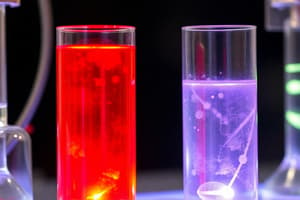Podcast
Questions and Answers
What does the term 'redox' in redox reactions stand for?
What does the term 'redox' in redox reactions stand for?
- Reduction and oxygenation
- Refraction and oxidation
- Reduction and oxidation (correct)
- Retention and oxidation
In a redox reaction, what happens to the species that gets oxidized?
In a redox reaction, what happens to the species that gets oxidized?
- Gains electrons
- Loses electrons (correct)
- Remains neutral
- Undergoes fusion
What is the main component connecting different redox couples in an electrochemical cell?
What is the main component connecting different redox couples in an electrochemical cell?
- Redox pairs
- Half-cell components
- External circuit (correct)
- Electrolyte solution
Which of the following is NOT a fundamental concept in electrochemistry as per the text?
Which of the following is NOT a fundamental concept in electrochemistry as per the text?
What is the primary focus of Faraday's laws of electrolysis?
What is the primary focus of Faraday's laws of electrolysis?
What is the purpose of an electrochemical cell?
What is the purpose of an electrochemical cell?
Which of the following is a product of water decomposition via electrolysis?
Which of the following is a product of water decomposition via electrolysis?
What is the relationship between mass transformed and charge passed in electrolysis according to Faraday's laws?
What is the relationship between mass transformed and charge passed in electrolysis according to Faraday's laws?
Which of the following is NOT a factor affecting electrochemical kinetics?
Which of the following is NOT a factor affecting electrochemical kinetics?
What did Michael Faraday emphasize in his discovery of Faraday's laws of electrolysis?
What did Michael Faraday emphasize in his discovery of Faraday's laws of electrolysis?
Flashcards are hidden until you start studying
Study Notes
Exploring Electrochemistry: Redox Reactions, Cells, and More
Electrochemistry is a discipline where chemistry meets electricity—a field centered around understanding and utilizing chemical conversions accompanied by electrical changes. At its core lie four fundamental concepts: redox reactions, electrochemical cells, electrolysis, Faraday’s laws of electrolysis, and electrochemical kinetics. Let’s dive into each one below.
Redox Reactions
Redox stands for reduction and oxidation. A redox reaction occurs when electrons are transferred between two species, shifting their oxidation states and resulting in either reduction or oxidation processes. These transferable particles called redox pairs are essential components of electrochemistry.
For instance, consider this reaction: [ \mathrm{~Zn}( s ) + \mathrm{Cu}^{2+} (\mathit{aq}) \longrightarrow \mathrm{Zn}^{2+}(\mathit{aq}) +\mathrm{Cu}(\mathit{s}) ] In this reaction, zinc metal loses electrons and gets oxidized from Zn → Zn²⁺; meanwhile, copper(II) ions gain electrons and get reduced from Cu²⁺ → Cu. This process represents a typical redox interaction.
Electrochemical Cells
An electrochemical cell or galvanic cell consists of at least two half-cells containing different redox couples connected through an external circuit. Each half-cell contains an oxidation-reduction reaction occurring spontaneously due to energy released during electron flow. Types of electrochemical cells include Daniell and Volta piles, batteries, fuel cells, and corrosion systems.
The overall potential difference generated by an electrochemical cell can be used to perform work and quantified using standard Gibbs free energies or Nernst equations.
Electrolysis
Conversely, electrolytic cells force electric current through ionic solutions, causing reduction and oxidation reactions to occur independently while separating elements or compounds. For example, water decomposition via electrolysis leads to the formation of hydrogen gas and oxygen gas: [ 2\mathrm{H}_2\mathrm{O} \longrightarrow 2\mathrm{H}_2(\mathit{g})+\mathrm{O}_2(\mathit{g})] Electrolysis has numerous applications, including producing high purity metals such as aluminum, halogens like chlorine, and purifying water.
Faraday's Laws of Electrolysis
Michael Faraday discovered these principles in 1832, emphasizing that mass change accompanying a chemical reaction (mass transformation) associated with passage of electricity (charge transfer) follows a proportional relationship expressed mathematically as: [ m=zFQ] where (m=\text {mass transformed}), (z=\text {number of equivalents (valence) }), (F=\text {Faraday constant}=96,!485 \text { Coulomb per equiv}), and (Q=\text {total charge passed}).
Electrochemical Kinetics
This topic addresses the rate of electrode reactions under various conditions. Factors affecting electrochemical kinetics include concentration, temperature, surface area, catalyst presence, and overpotential. Understanding electrochemical kinetics helps engineers and scientists optimize battery performance, design sensors, and create more efficient industrial processes.
These foundational principles intertwine synergistically within the vast landscape of electrochemistry. Uncovering and applying them fosters innovation across technologies ranging from everyday devices to cutting-edge research projects.
Studying That Suits You
Use AI to generate personalized quizzes and flashcards to suit your learning preferences.




